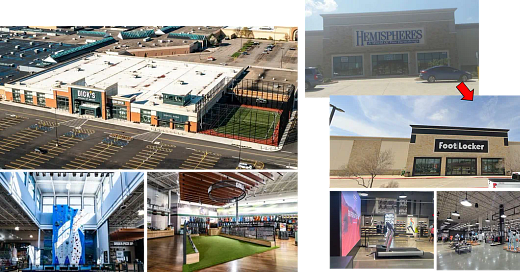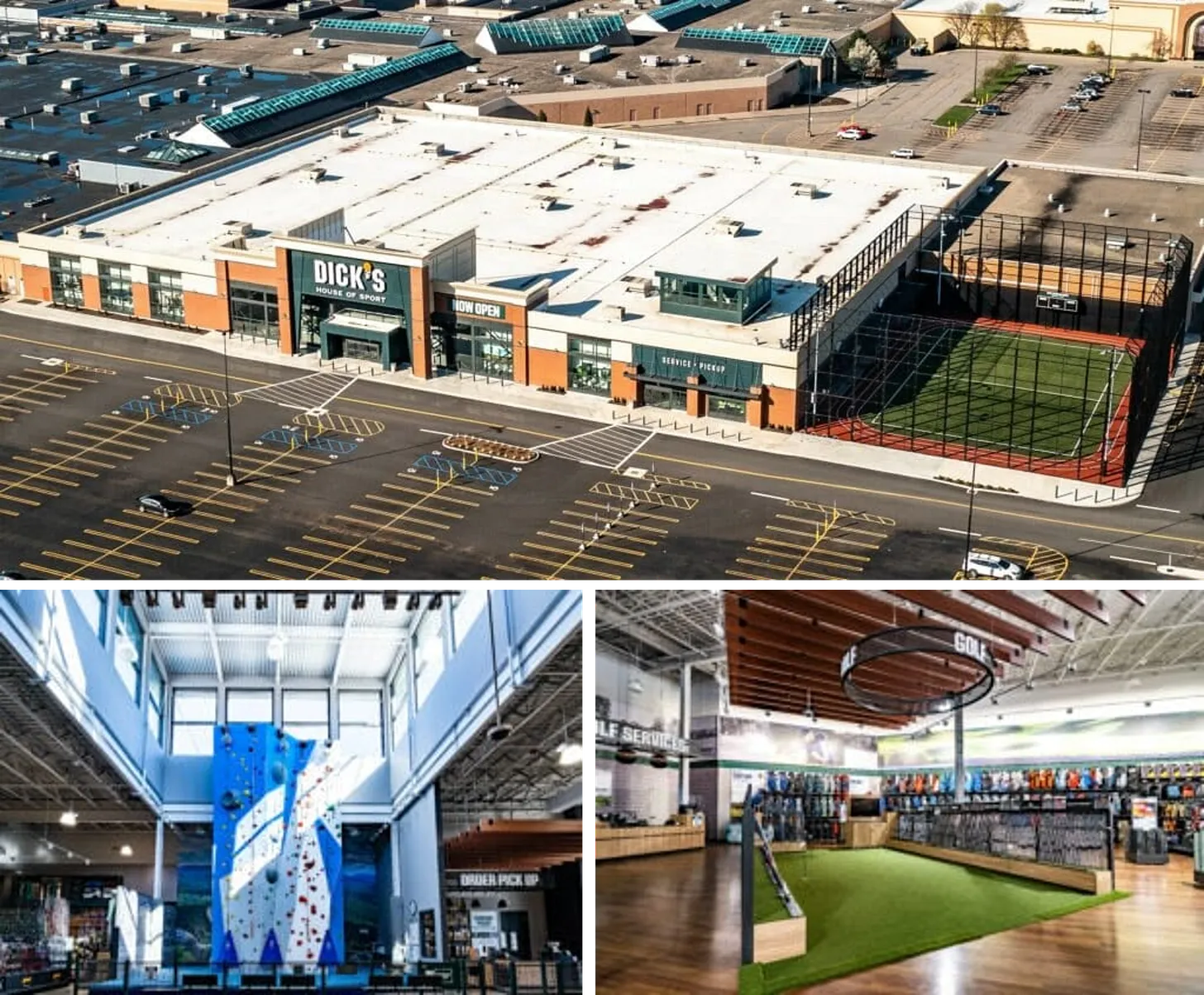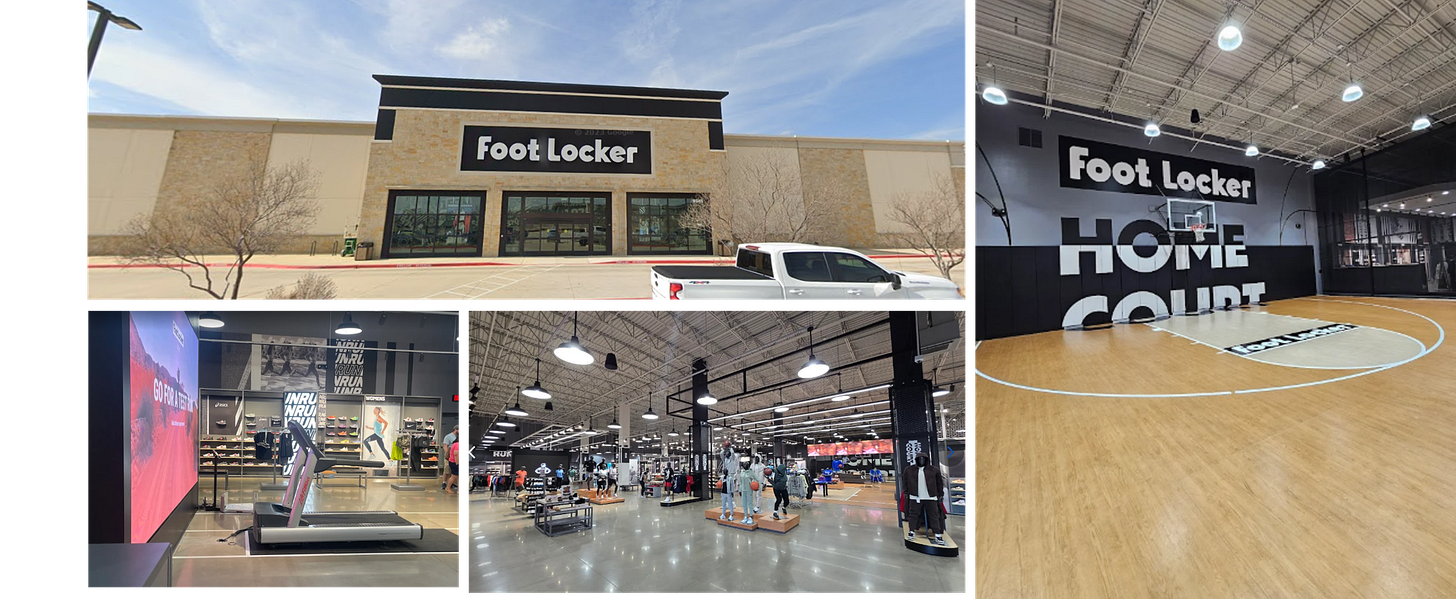Why The Acquisition of Foot Locker By Dick's Sporting Goods May Accelerate Adaptive Reuse of Vacant Real Estate
Dick's Sporting Goods is repurposing mall department stores in "experiential" formats; Foot Locker has pursued a similar reuse strategy but on a smaller scale with former drugstore and Big Box sites
The big news in the retail world last week was the offer made by Dick’s Sporting Goods DKS 0.00%↑ to acquire Foot Locker FL 0.00%↑.
While the two companies both operate in the athletic retail space, Dick’s is a full-line sporting goods retailer that operates in Big Box real estate while Foot Locker has historically sold footwear and apparel out of mall-based stores.
But in recent years both Dick’s and Foot Locker have allocated significant resources to remake their stores in “experiential” formats.
And, ironically, the two companies have pursued parallel real estate strategies to upgrade — and enlarge — their stores.
The common thread?
Both companies have relied on the repurpose of vacant retail real estate:
Dick’s has converted department stores at regional malls while Foot Locker has backfilled former drugstores and Big Box suites.
In 2021 Dick’s Sporting Goods introduced its House of Sport concept when it repurposed a vacant, ~100,000 square foot former Sears department store at the Eastview Mall in the Rochester, New York area.
Dick’s House of Sport is more than twice the size of a conventional Dick’s Sporting Goods Big Box store and includes experiential features such as tennis courts, batting cages, rock climbing walls, a simulated driving range and even a ~17,000 square foot turf field that converts to an ice rink in the winter.
Dick’s has aggressively expanded the concept in recent years and plans to quadruple the number of its 100,000 - 150,000 square foot House of Sport stores by 2027.
Many of these future House of Sport locations will be developed via the adaptive reuse of vacant buildings — especially mall department stores.
Like Dick’s, Foot Locker has also been focused on experiential real estate — albeit on a smaller scale than House of Sport.
Foot Locker operates ~2,400 stores globally, nearly 60% of which are in enclosed shopping malls.
But Foot Locker is more than halfway through a real estate transformation that has resulted in the closure of several hundred mall stores.
At the same time, the Company has accelerated the opening of larger “off mall” store formats — like Power Stores which were designed to be hubs for local sneaker culture, art, music and sports.
Foot Locker Power Stores average 10,000 - 15,000 square feet, or 3-5x the size of one of the Company’s typical mall stores.
Foot Locker has relied on adaptive reuse and the backfill of “2nd generation” real estate to open these larger stores.
As evidenced by the first Foot Locker Power Store which opened in the Metro Detroit area back in 2019.
In a repurposed former Walgreens drugstore.
In addition to repurposing former drugstores, Foot Locker has also moved into larger junior box suites that were vacated by furniture retailers.
Like its backfill of a freestanding former Thomasville Furniture store in Metro Detroit.
One store that Foot Locker opened in a Texas shopping center is even larger.
In 2023 Foot Locker repurposed a ~36,000 square foot former Hemispheres Home Furnishings store in North Fort Worth into one of its largest stores.
Foot Locker added several experiential features including an indoor basketball court and running wear test station.
In a Big Box space that is ~10x the size of a standard mall store!
Foot Locker’s transition to larger, experimental store formats parallels the real estate efforts of Dick’s Sporting Goods with House of Sport.
And the success of the initial House of Sport sites have led Dick’s to make the concept a bigger part of its future real estate plans.
Now Dick’s expects to operate ~100 House of Sport stores by 2027 and intends to leverage a growing pipeline of vacant department store boxes at regional malls to develop the stores via adaptive reuse.
There is also ample available real estate should Foot Locker accelerate its transition to experiential formats.
Two Rite Aid bankruptcies in the past two years and mass store closures by CVS and Walgreens have left thousands of vacant former drugstores on the market.
Including some that have already been backfilled not only by Foot Locker but also by other shoe retailers.
There is also newly available real estate should Foot Locker elect to grow its nascent Big Box format.
Recent bankruptcies of Bed Bath & Beyond, Joann, Big Lots and other retailers have left plenty of 2nd generation Big Box real estate ready for conversion into other store formats.
Dick’s and Foot Locker have operated on parallel paths to repurpose vacant real estate into larger stores with experiential features.
But now that both retailers are likely past the testing stage of their new formats, a Dick’s/Foot Locker combination has the potential to accelerate “experiential” adaptive reuse across multiple types of real estate.
And perhaps backfill the many vacant department stores, drugstores and Big Box spaces at an even faster rate!









